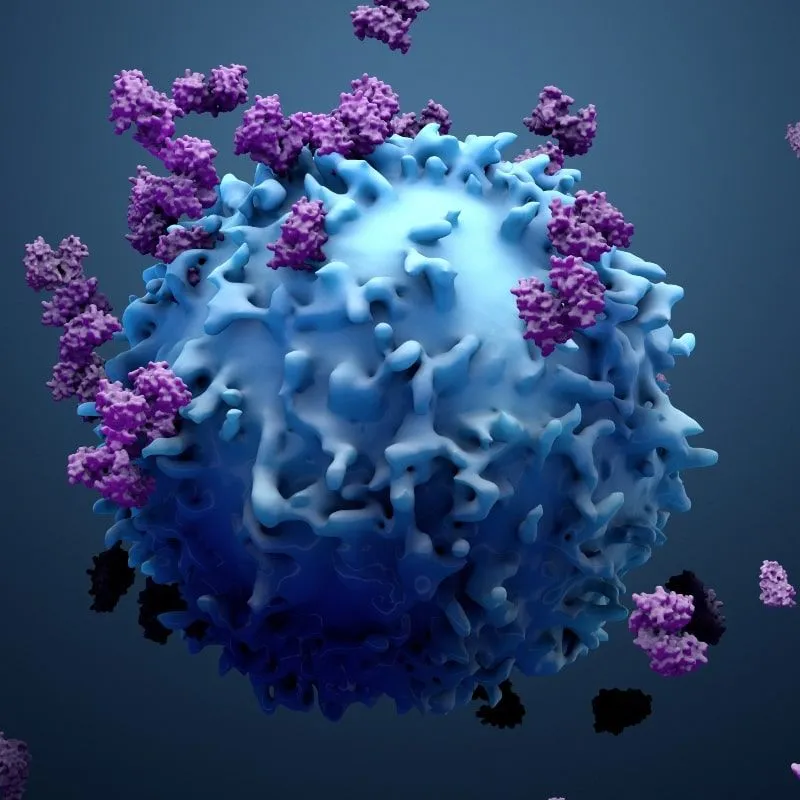What are the Subtypes of T-Cell Lymphoma?

T-cell lymphoma is a rare and complex type of cancer that begins in T cells, a crucial cell of the immune system. When these white blood cells become abnormal and grow uncontrollably, they can invade various parts of the body, such as the lymph nodes, bone marrow, skin, spleen, and liver.
T-cell lymphomas can range from slow-growing (indolent) forms to aggressive types that progress rapidly. The treatment approach and outlook depend on the specific type and stage of the cancer, with options ranging from careful monitoring to advanced therapies like stem cell transplantation
What are the Subtypes of T-Cell Lymphoma?
Peripheral T-Cell Lymphoma (PTCL)
This is a group of aggressive blood cancers that affect the lymph nodes and are a type of Non-Hodgkin lymphoma. This is a rare cancer because it originates in the T-cells (most cancers begin in the B-cells).
The most common sign of PTCL is painless swelling in the neck, armpit or groin. Prognosis depends on the stage. But, in general, the 5 year survival rate is 30-40%.
Anaplastic Large Cell Lymphoma (ALCL)
This is a rare, aggressive and fast growing type of Non-Hodgkin lymphoma that develops when T-cells become abnormal. These cancer cells express a marker called CD30 or Ki-1 on the surface. ALCL can appear in the lymph nodes, skin, bones, soft tissues, lungs or liver.
Symptoms may include painless swelling in the neck, armpit or groin. Night sweats, fevers, weight loss and fatigue may also occur. This cancer can be challenging to diagnose because it may look similar to other malignancies.
Angioimmunoblastic T-Cell Lymphoma (AITL)
This is a rare, fast growing, aggressive type of Non-Hodgkin lymphoma that affects the lymph nodes. Thus, there may be painless swelling in the neck, armpit or groin. Patients may experience a high fever, skin rash, unexplained itching, low blood cell count and inflammation in the joints.
AITL mainly affects older, male adults (approximately 70 years old). It appears there may be a correlation with the Epstien-Barr virus. This cancer can shut down the immune system and cause severe symptoms.
T-Cell Lymphoblastic Lymphoma (T-LBL)
This is a rare and aggressive subtype that is more common in adolescents and young adults. T-LBL often develops tumors in the mediastinum (the middle of the chest), but can also appear in the lymph nodes, bone marrow or spleen. There is no standard treatment and the prognosis is poor when it re-appears even after therapy (relapse). It is shares similarities to T-Cell Acute Lymphoblastic Leukemia (T-ALL).
Cutaneous T-Cell Lymphoma (CTCL)
This is a rare, chronic and treatable type of cancer that affects the skin. It generally begins as a red, itchy and scaly rash that can thicken and form tumors. Other symptoms can include: dry skin, night sweats, fever and some autoimmune disorders. The most common types of CTCL are mycosis fungoides and Sézary syndrome.
CTCLs grow slowly, are not contagious and are not life threatening. But, the sooner treatment begins, the better. Advanced stages can present severe symptoms.
Learn more from your subtype!
For all T-cell lymphoma subtypes, there are different treatments and monitoring by health professionals. If you've been diagnosed with T-cell lymphoma and want to learn more, you can visit the links from the specific subtypes, where we offer comprehensive information for patients and caregivers.
Stay tuned for more content by creating a free HealthTree account! You can use many of our free resources and stay on top of your health.
T-cell lymphoma is a rare and complex type of cancer that begins in T cells, a crucial cell of the immune system. When these white blood cells become abnormal and grow uncontrollably, they can invade various parts of the body, such as the lymph nodes, bone marrow, skin, spleen, and liver.
T-cell lymphomas can range from slow-growing (indolent) forms to aggressive types that progress rapidly. The treatment approach and outlook depend on the specific type and stage of the cancer, with options ranging from careful monitoring to advanced therapies like stem cell transplantation
What are the Subtypes of T-Cell Lymphoma?
Peripheral T-Cell Lymphoma (PTCL)
This is a group of aggressive blood cancers that affect the lymph nodes and are a type of Non-Hodgkin lymphoma. This is a rare cancer because it originates in the T-cells (most cancers begin in the B-cells).
The most common sign of PTCL is painless swelling in the neck, armpit or groin. Prognosis depends on the stage. But, in general, the 5 year survival rate is 30-40%.
Anaplastic Large Cell Lymphoma (ALCL)
This is a rare, aggressive and fast growing type of Non-Hodgkin lymphoma that develops when T-cells become abnormal. These cancer cells express a marker called CD30 or Ki-1 on the surface. ALCL can appear in the lymph nodes, skin, bones, soft tissues, lungs or liver.
Symptoms may include painless swelling in the neck, armpit or groin. Night sweats, fevers, weight loss and fatigue may also occur. This cancer can be challenging to diagnose because it may look similar to other malignancies.
Angioimmunoblastic T-Cell Lymphoma (AITL)
This is a rare, fast growing, aggressive type of Non-Hodgkin lymphoma that affects the lymph nodes. Thus, there may be painless swelling in the neck, armpit or groin. Patients may experience a high fever, skin rash, unexplained itching, low blood cell count and inflammation in the joints.
AITL mainly affects older, male adults (approximately 70 years old). It appears there may be a correlation with the Epstien-Barr virus. This cancer can shut down the immune system and cause severe symptoms.
T-Cell Lymphoblastic Lymphoma (T-LBL)
This is a rare and aggressive subtype that is more common in adolescents and young adults. T-LBL often develops tumors in the mediastinum (the middle of the chest), but can also appear in the lymph nodes, bone marrow or spleen. There is no standard treatment and the prognosis is poor when it re-appears even after therapy (relapse). It is shares similarities to T-Cell Acute Lymphoblastic Leukemia (T-ALL).
Cutaneous T-Cell Lymphoma (CTCL)
This is a rare, chronic and treatable type of cancer that affects the skin. It generally begins as a red, itchy and scaly rash that can thicken and form tumors. Other symptoms can include: dry skin, night sweats, fever and some autoimmune disorders. The most common types of CTCL are mycosis fungoides and Sézary syndrome.
CTCLs grow slowly, are not contagious and are not life threatening. But, the sooner treatment begins, the better. Advanced stages can present severe symptoms.
Learn more from your subtype!
For all T-cell lymphoma subtypes, there are different treatments and monitoring by health professionals. If you've been diagnosed with T-cell lymphoma and want to learn more, you can visit the links from the specific subtypes, where we offer comprehensive information for patients and caregivers.
Stay tuned for more content by creating a free HealthTree account! You can use many of our free resources and stay on top of your health.

about the author
Lisa Foster
Lisa Foster is a mom of 3 daughters and 1 perfect grandchild, a puzzle lover, writer and HealthTree advocate. She believes in the mission of the foundation and the team that builds it forward. She calls Houston, Texas home.
More on Navigating Your Health
Get the Latest Lymphoblastic Lymphoma Updates, Delivered to You.
By subscribing to the HealthTree newsletter, you'll receive the latest research, treatment updates, and expert insights to help you navigate your health.
Thanks to our HealthTree Community for Lymphoblastic Lymphoma Sponsors:













